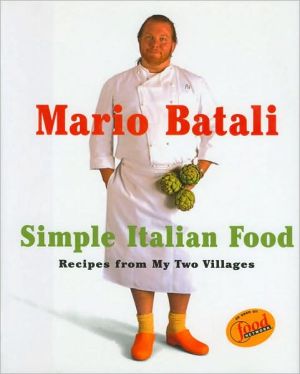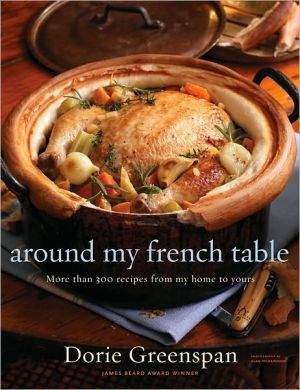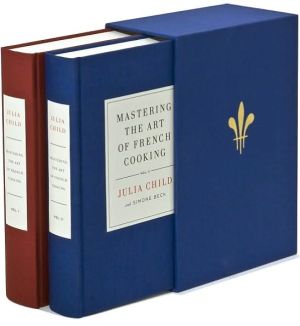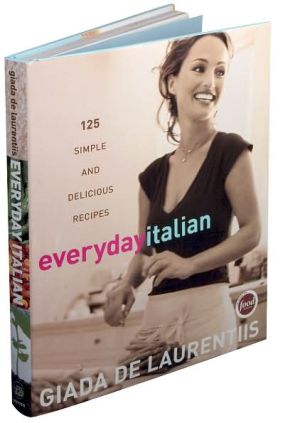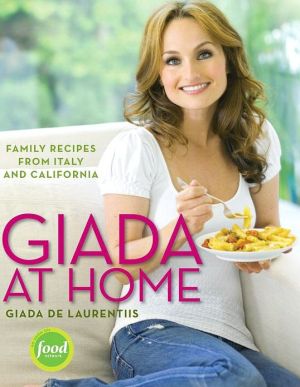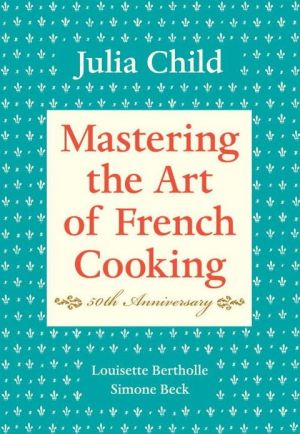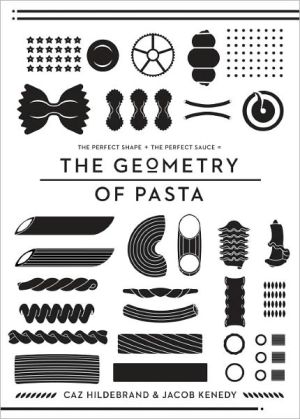Simple Italian Food: Recipes from My Two Villages
Perfectly pristine ingredients, combined sensibly and cooked properly, are the unmistakable hallmarks of the best Italian food. Chef Mario Batali, known to fans far and wide as "Molto Mario" from his appearances on television's Food Network and as chef of New York's much-loved Pó restaurant, has elevated these simple principles to fine art, creating innovative new fare that pays tribute to traditional Italian home cooking in a distinctly modern way. Now, for the first time, more than 200 of...
Search in google:
Perfectly pristine ingredients, combined sensibly and cooked properly, are the unmistakable hallmarks of the best Italian food. Chef Mario Batali, known to fans far and wide as "Molto Mario" from his appearances on television's Food Network and as chef of New York's much-loved Pó restaurant, has elevated these simple principles to fine art, creating innovative new fare that pays tribute to traditional Italian home cooking in a distinctly modern way. Now, for the first time, more than 200 of his irresistible recipes for fresh pastas, sprightly salads, grilled dishes, savory ragus, and many others are gathered in Simple Italian Food, a celebration of the flavors and spirit of Italy. Mario draws inspiration for his distinctive dishes from the two "villages" that have left their stamps on his cuisine: Borgo Capanne, the tiny hillside village in Northern Italy where he lived and cooked for several years, and New York's Greenwich Village, where he has ready access to bountiful produce and outstanding artisan-made products; his full-flavored, smartly presented fare combines the best of both worlds. Chapters covering antipasti, pasta and risotto, fish, meat and poultry, contorni (side dishes), and cheese and sweets offer classic dishes such as Baked Lasagne with Asparagus and Pesto and pork loin cooked in caramelized onions and milk alongside Batali's own enticing improvisations—Penne with Spicy Goat Cheese and Hazelnut Pesto or Tuna Carpaccio with Cucumbers, Sweet Potatoes, and Saffron Vinaigrette. And because his recipes succeed on the strength of their ingredients rather than on virtuoso techniques, home cooks can easily duplicate the clear, clean flavors and lively presentations that are Mario's signature. Thirty-two pages of color photographs showcase Chef Batali's colorful and approachable recipes. Traditionalists as well as those who thrill to the new will want to make dozens of these crowd-pleasing dishes a permanent part of their repertoire and embrace Mario Batali'sphilosophy of Simple Italian Food. Bon Appetit - Tricia Callas According to Mario Batali, when it comes to Simple Italian Food, there is no substitute for perfectly pristine ingredients combined sensibly and cooked properly. This chef owner of Po and Babbo in New York, and the the host of two shows on the Food Network was influenced by two villages when he created the irresistible recipes in this book: Borgo Cappanne, a mountain town in Emilia-Romagna and Greenwich Village, the neighborhood where he works now. The result is terrfic food like white bean bruschetta with grilled radicchio salad, and grilled chicken in tapenade with broccoli rabe...that does require a chef's experience to prepare.
Introduction\ Simplicity.\ An unremarkable word, and one that is perhaps overused today. It is nonetheless one of the most fundamental and at the same time most elusive keys to preparing food well. Certainly it is the absolute cornerstone of the spectacular and glorious regional Italian fare that has so influenced my approach to cooking. It is also the object of my desire, whether I am re-creating a 100-year-old dish from the hill country between Bologna and Firenze, or creating a new dish to demonstrate on television. It is certainly my design when cooking at home for friends and family and what is expected at my restaurants, Pó and Babbo, in New York City.\ Perfectly pristine ingredients, combined sensibly and cooked properly, are what make Italian food taste so good, both in Italy and here in the United States. Reducing the distance and time food spends on its journey from the soil to the plate is the modus operandi for all Italian cooks--and those who wish to cook in the Italian style. From the young pizzaiaoli to the savvy homemakers, buying the freshest, peak-of-season produce is a habit that is observed for every meal, every day, always. A special holiday may be celebrated with a complex five-course meal; for other days, an arugula salad with shaved cheese and some spaghetti with hot pepper, garlic, and olive oil may do. But in either case, the rigorous pursuit of incomparable freshness elevates the seemingly banal to the superb.\ Prosciutto di Parma with Fresh Stuffed Figs\ serves 4\ Figs stuffed with Gorgonzola creates an almost sweet and sour sensation in my mouth that can challenge the prosciutto. To achieve the perfect balance of flavors in each bite I generally cut the figs into quarters and wrap each quarter in a slice of prosciutto.\ 12 black mission or Kadota figs\ 6 ounces Gorgonzola cheese, softened to room temperature\ 2 tablespoons finely chopped walnuts\ 2 bunches Italian parsley, finely chopped (1/2cup)\ 8 ounces prosciutto di Parma, sliced paper-thin\ Preheat the oven to 450 F.\ Quarter the figs lengthwise, cutting down from the stem but leaving the segments attached at the base. Place on an ungreased baking sheet.\ In a mixing bowl, stir together the Gorgonzola, walnuts and parsley until well mixed. Using a tablespoon, stuff 1tablespoon of the filling into each open fi. Bake the figs for 8 to 10 minutes, until the cheese filling is bubbling.\ Arange 3 or 4 slices of prosciutto on each of 4 plates. Remove the figs from the oven, place three in center of each plate, and serve immediately.\ Linguine with Manila Clams, Pancetta, and Chiles\ serves 4\ Traditionalist scoff at the combination of pork and shellfish in this Pó classic, but I find that just a small amount of bacon rounds out the flavor in a big way. Traditional Portuguese cooks were, of course, light-years ahead of me with their cataplana of chorizo and clams.\ 6 tablespoons extra-virgin olive oil\ 1/2 medium red onion, minced\ 1/4 pound pancetta, cut into 1/8-inch dice\ 4 garlic cloves, thinly sliced\ 1 teaspoon hot red pepper flakes\ 1 pound Manila clams, scrubbed and rinsed\ 2 cups dry white wine\ 4 tablespoons (1/2 stick) unsalted butter\ 10 ounces dried linguine\ 1/4 cup finely chopped Italian parsley\ Bring 6 quarts of water to a boil and add about 2 tablespoons of salt.\ In a large sauté pan, heat the olive oil and sauté the onion, pancetta, and garlic over medium heat until the onion is very soft and the pancetta is translucent, about 10 minutes.\ Add the red pepper flakes, clams, wine, and butter and bring to a boil. Cook just until all the clams have opened, 5 to 7 minutes, and then set aside. Discard any clams that did not open.\ Boil the linguine according to package directions, until tender yet still al dente. Drain the pasta and toss into the pan with the clams. Stir gently to mix; this should still be a little brothlike. Add the parsley, pour into a warm serving bowl, and serve.\ T-Bone Fiorentina with Sautéed Spinach and Da Vero Oil\ serves 4\ This recipe generated the largest number of recipe requests (and the most oohs and aahs from the production staff) of any dish I've ever demonstrated on Molto Mario. Traditionally cooked and simply presented, this is perhaps the definitive Tuscan dish.\ 1 t-bone steak, at least 3 inches thick (3 to 3 1/2 pounds)\ 1 tablespoon chopped fresh rosemary leaves\ 1 tablespoon chopped fresh sage leaves\ 1 tablespoon fresh thyme leaves\ 2 tablespoons freshly ground black pepper\ 2 tablespoons kosher salt\ 3/4 cups plus 2 tablespoons best-quality extra-virgin olive oil\ 1/4 cup virgin olive oil\ 6 garlic cloves, thinly sliced\ 4 pounds spinach, washed, spun dry, stems removed juice of 1 lemon salt and pepper\ Prepare a charcoal fire or preheat the grill to medium-high heat.\ Pat the steak dry. In a small bowl, combine the rosemary, sage, thyme, black pepper and kosher salt until well-blended. Coat the entire steak with the spice mix and brush with 2 tablespoons of the extra-virgin olive oil. Place on the grill and cook until well charred, about 12 minutes on the first side and 9 minutes on the second side. Let stand 5 minutes.\ Meanwhile, in a 12- to 14-inch saute pan, heat the virgin olive oil until smoking. Add the garlic and cook until light brown, 3 to 4 minutes. Add the spinach and stir quickly, cooking just until wilted. Remove from the heat, add the lemon juice and salt and pepper, and set aside.\ Carve the filet and strip steaks off the bone and slice. Divide the spinach and steak among 4 plates, giving each some of the filet, and drizzle each serving with a few tablespoons of the remaining extra-virgin olive oil.
\ From Barnes & NobleThe Barnes & Noble Review\ Mario Batali is a chef who truly loves food, as the many fans of his Food Network shows, 'Molto Mario' and 'Mediterranean Mario,' well know. So do those diners lucky enough to have sampled his cuisine firsthand, at his beloved New York City restaurant Pó and his hot new Babbo. His rustic, simple, yet innovative food is drawn from two major sources — his two villages. One is Borgo Capanne, the tiny hillside village in Northern Italy where Mario lived and cooked for several years; the other is New York City's Greenwich Village. In Borgo Capanne, Mario learned the secrets of Italian home cooks and professional chefs, cooking their traditional dishes and understanding the simple combinations of excellent ingredients and clear flavors that characterizes true Italian cuisine. In Greenwich Village, he fell in love with the incomparable specialty produce from the city's farmers' markets and the artisanal products, from cheeses and free-range chickens to cured meats, made by nearby culinary craftspeople. These two influences have combined in Mario's cuisine to yield uniquely innovative yet authentic dishes that are surprisingly accessible to the home cook, as he proves in his long-awaited new cookbook, Mario Batali Simple Italian Food. \ Imagine sitting down to a delicate but hearty dish of Baked Lasagne with Asparagus and Pesto, or Balsamic Glazed Chicken with Grilled Radicchio. Or how about Black Olive Polenta with Shiitakes, Garlic, and Rosemary, or Rigatoni with Sheep's Milk Cheese, Black Pepper, and Arugula? This is the kind of food that lovers of Italian cuisinecouldhappily eat every night of the week, and they'll find plenty of dishes in Mario Batali Simple Italian Food that are perfectly suited to time-crunched weeknight dinners. Which is not to say that there aren't a few perfect special-occasion dishes included — from Sautéed Langostinos in Almond Flour Crust with Sweet and Hot Chiles to Stuffed Veal Rolls made with wild mushrooms and fresh herbs — but even these are simple enough for everyday, with only costly ingredients pushing them into the realm of the celebratory. If you love Italian food, and if you love to cook using great ingredients and simple recipes written by a personable and creative chef, Mario Batali Simple Italian Food will find a place among your most-used cookbooks. — —Kate Murphy Zeman\ \ \ \ \ \ Tricia CallasAccording to Mario Batali, when it comes to Simple Italian Food, there is no substitute for perfectly pristine ingredients combined sensibly and cooked properly. This chef owner of Po and Babbo in New York, and the the host of two shows on the Food Network was influenced by two villages when he created the irresistible recipes in this book: Borgo Cappanne, a mountain town in Emilia-Romagna and Greenwich Village, the neighborhood where he works now. The result is terrfic food like white bean bruschetta with grilled radicchio salad, and grilled chicken in tapenade with broccoli rabe...that does require a chef's experience to prepare. \ — Bon Appetit\ \
